Objectives:
• State the purpose and general principles of electric motor control.
• State the difference between manual and remote control.
• List the conditions of starting and stopping, speed control, and protection of electric motors.
• Explain the difference between compensating and definite time delay action.
There are certain conditions that must be considered when selecting, designing, installing, or maintaining electric motor control equipment.
The general principles are discussed to help understanding and to motivate students by simplifying the subject of electric motor control.
Motor control was a simple problem when motors were used to drive a common line shaft to which several machines were connected. It was simply necessary to start and stop the motor a few times a day. However, with individual drive, the motor is now almost an integral part of the machine and it's necessary to de sign the motor controller to fit the needs of the machine to which it's connected. Large installations and the problems of starting motors in these situations may be observed in ill. 1 and ill. 2.
Motor control is a broad term that means any thing from a simple toggle switch to a complex system with components such as relays, timers, and switches. The common function of all controls, however, is to control the operation of an electric motor. As a result, when motor control equipment is selected and installed, many factors must be considered to ensure that the control will function properly for the motor and the machine for which it's selected.
MOTOR CONTROL INSTALLATION CONSIDERATIONS
When choosing a specific device for a particular application, it's important to remember that the motor, machine, and motor controller are interrelated and need to be considered as a package. In general, five basic factors influence the selection and installation of a controller.
1. ELECTRICAL SERVICE
Establish whether the service is direct (DC) or alternating current (AC). If AC, deter mine the frequency (hertz) and number of phases in addition to the voltage.
2. MOTOR
The motor should be matched to the electrical service and correctly sized for the ma chine load in horsepower rating (hp). Other considerations include motor speed and torque. To select proper protection for the motor, its full-load current rating (FLC), service factor (SF), time rating (duty), and other pertinent data-as shown on the motor nameplate-must be used.

ill. 1 Five 2000 hp, 1800 rpm induction motors driving water pumps for a
Texas oil/water operation. Pumps are used to force water into the ground and "float" oil
upward.

ill. 2 Horizontal 4000 hp synchronous motor driving a large centrifugal
air compressor.
3. OPERATING CHARACTERISTICS OF CONTROLLER
The fundamental tasks of a motor controller are to start and stop the motor and to protect the motor, machine, product, and operator. The controller may also be called upon to provide supplementary functions such as reversing, jogging or inching, plugging, or operating at several speeds or at reduced levels of current and motor torque (see Glossary). Section 430 of the National Electrical Code (NEC) provides requirements concerning the installation of motor circuits. This section is employed to deter mine the proper conductor size, overload size, and short circuit protection rating for motor installations. In some industries electrical engineers are responsible for determining the requirements for installing a motor or motors. In other industries the electrician is expected to perform this task.
4. ENVIRONMENT
Controller enclosures serve to provide safety protection for operating personnel by preventing accidental contact with live parts. In certain applications, the controller itself must be protected from a variety of environmental conditions, which might include:
++ Water, rain, snow, or sleet
++ Dirt or noncombustible dust
++ Cutting oils, coolants, or lubricants
Both personnel and property require protection in environments made hazardous by the presence of explosive gases or combustible dusts.
5. ELECTRICAL CODES AND STANDARDS
Motor control equipment is designed to meet the provisions of the National Electrical Code (NEC). Also, local code requirements must be considered and met when installing motors and control de vices. Presently, code sections applying to motors, motor circuits, and controllers and industrial control devices are found in Article 430 on motors and motor controllers, Article 440 on air-conditioning and refrigeration equipment, and Article 500 on hazardous locations of the NEC.
The 1970 Occupational Safety and Health Act (OSHA), as amended, requires that each employer furnish employment in an environment free from recognized hazards likely to cause serious harm.
Standards established by the National Electrical Manufacturers Association (NEMA) assist users in the proper selection of control equipment. NEMA standards provide practical information concerning the construction, testing, performance, and manufacture of motor control devices such as starters, relays, and contactors.
One of the organizations that actually tests for conformity to national codes and standards is Underwriters' Laboratories (UL). Equipment that's tested and approved by UL is listed in an annual publication, which is kept current by means of bimonthly supplements to reflect the latest additions and deletions. A UL listing does not mean that a product is approved by the NEC. It must be acceptable to the local authority having jurisdiction.

ill. 3 Synchronizing Two Automobile Assembly Systems.

ill. 4
Combination fused disconnect switch and motor starter.
PURPOSE OF CONTROLLER
Some of the complicated and precise automatic applications of electrical control are illustrated in ill. 3 and ills 7A and B.
Factors to be considered when selecting and in stalling motor control components for use with particular machines or systems are described in the following paragraphs.
Starting
The motor may be started by connecting it directly across the source of voltage. Slow and gradual starting may be required, not only to protect the machine, but also to ensure that the line current inrush on starting isn't too great for the power company's system. Some driven machines may be damaged if they are started with a sudden turning effort. The frequency of starting a motor is another factor affecting the controller. A combination fused disconnect switch and motor starter is shown in ill. 4.
Stopping
Most controllers allow motors to coast to a standstill. Some impose braking action when the machine must stop quickly. Quick stopping is a vital function of the controller for emergency stops. Controllers assist the stopping action by retarding centrifugal motion of machines and lowering operations of crane hoists.
Reversing
Controllers are required to change the direction of rotation of machines automatically or at the command of an operator at a control station. The reversing action of a controller is a continual process in many industrial applications.
Running
The maintaining of desired operational speeds and characteristics is a prime purpose and function of controllers. They protect motors, operators, machines, and materials while running.
There are many different types of safety circuits and devices to protect people, equipment, and industrial production and processes against possible injury that may occur while the machines are running.
Speed Control
Some controllers can maintain very precise speeds for industrial processes. Other controllers can change the speeds of motors either in steps or gradually through a continuous range of speeds.
Safety of Operator
Many mechanical safeguards have been re placed or aided by electrical means of protection.
Electrical control pilot devices in controllers pro vide a direct means of protecting machine operators from unsafe conditions.
Protection from Damage
Part of the operation of an automatic machine is to protect the machine itself and the manufactured or processed materials it handles. E.g., a certain machine control function may be the prevention of conveyor pileups. A machine control can reverse, stop, slow, or do whatever is necessary to protect the machine or processed materials.
Maintenance of Starting
Requirements Once properly installed and adjusted, motor starters will provide reliable operation of starting time, voltages, current, and torques for the benefit of the driven machine and the power system.
The NEC, supplemented by local codes, governs the selection of the proper sizes of conductors, starting fuses, circuit breakers, and disconnect switches for specific system requirements.
MANUAL CONTROL
A manual control is one whose operation is accomplished by mechanical means. The effort required to actuate the mechanism is almost al ways provided by a human operator. The motor may be controlled manually using any one of the following devices.
Toggle Switch
A toggle switch is a manually operated electric switch. Many small motors are started with toggle switches. This means the motor may be started directly without the use of magnetic switches or auxiliary equipment. Motors started with toggle switches are protected by the branch circuit fuse or circuit breaker. These motors generally drive fans, blowers, or other light loads.
Safety Switch
In some cases it's permissible to start a motor directly across the full-line voltage if an externally operated safety switch is used (EXO), ill. 5. The motor receives starting and running protection from dual-element, time-delay fuses. The use of a safety switch requires manual operation. A safety switch, therefore, has the same limitations common to most manual starters.
Drum Controller
Drum controllers are rotary, manual switching devices that are often used to reverse motors and to control the speed of AC and DC motors. They are used particularly where frequent start, stop, or reverse operation is required. These controllers may be used without other control components in small motors, generally those with fractional horsepower ratings. Drum controllers are used with magnetic starters in large motors. A drum controller is shown in ill. 6.
Faceplate Control
Faceplate controllers have been in use for many years to start DC motors. They have been used for AC induction motor speed control. The faceplate control has multiple switching contacts mounted near a selector arm on the front of an insulated plate. Additional resistors are mounted on the rear to form a complete unit.
Technological developments, however, have fewer faceplate controllers being installed.
REMOTE AND AUTOMATIC CONTROL
The motor may be controlled by remote control using push buttons, ills 7A and B.
When push-button remote control is used or when automatic devices don't have the electrical capacity to carry the motor starting and running currents, magnetic or electric switches must be included. Magnetic switch control is one whose operation is accomplished by electro magnetic means. The effort required to actuate the electromagnet is supplied by electrical energy rather than by the human operator. If the motor is to be automatically controlled, the following two-wire pilot devices may be used.

ill. 5 Safety disconnect switch (EXO). (Eaton Corporation) ill. 6 Drum
controller with cover (left) and with cover removed (right). (Eaton Corporation)
Float Switch The raising or lowering of a float that's mechanically attached to electrical contacts may start motor-driven pumps to empty or fill tanks. Float switches are also used to open or close piping solenoid valves to control fluids, ill. 8. There are other similar methods that achieve the same results.
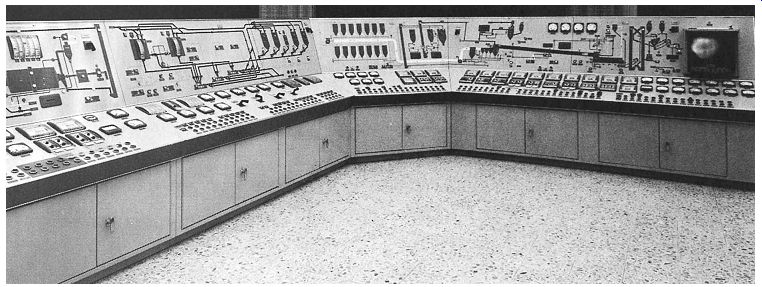
ill. 7(A) Typical cement mill computer console carefully controlling and monitoring motors located remotely.
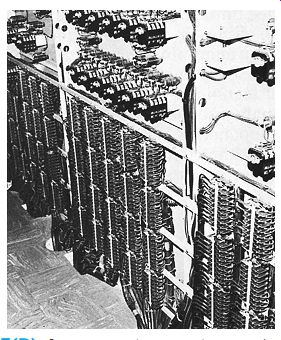
ill. 7(B) Some typical terminal wiring behind the control panels shown
in part A.
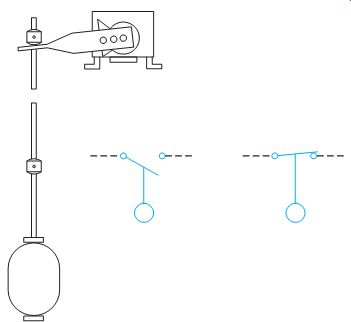
ill. 8 Rod-operated float switch with electrical wiring symbols.
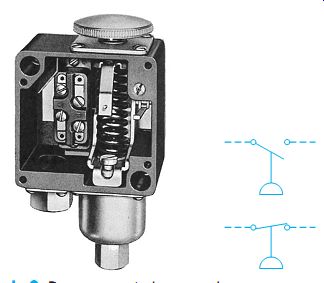
ill. 9 Pressure switches may be necessary to start the
motors shown in ill. 10. (Schneider Electric)

ill. 10 Two 1500 hp vertical induction
motors driving pumps.
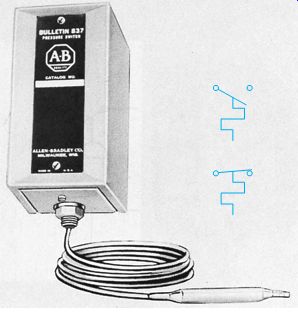
ill. 11 Industrial
temperature switch with extension bulb and electrical wiring symbols.
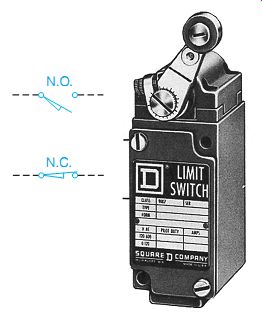
ill.
12 Limit switch shown with electrical wiring symbols. (Schneider Electric)
Pressure Switch Pressure switches are used to control the pres sure of liquids and gases (including air) within a desired range, ill. 9. Air compressors, for example, are started directly or indirectly on a call for more air by a pressure switch. Electrical wiring symbols are shown as normally closed and normally open in ill. 9.
Time Clock Time clocks can be used when a definite "on and off " period is required and adjustments are not necessary for long periods of time. A typical requirement is a motor that must start every morning at the same time and shut off every night at the same time, or switches the flood lights on and off.
Thermostat In addition to pilot devices sensitive to liquid levels, gas pressures, and time of day, thermostats sensitive to temperature changes are widely used, ill. 11. Thermostats indirectly control large motors in air-conditioning systems and in many industrial applications to maintain the desired temperature range of air, gases, liquids, or solids.
There are many types of thermostats and temperature-actuated switches.
Limit Switch Limit switches, ill. 12, are designed to pass an electrical signal only when a predetermined limit's reached. The limit may be a specific position for a machine part or a piece of work, or a certain rotating speed. These devices take the place of a human operator and are often used under conditions where it would be impossible or impractical for the operator to be present or to efficiently direct the machine.
Limit switches are used most frequently as overtravel stops for machines, equipment, and products in process. These devices are used in the control circuits of magnetic starters to govern the starting, stopping, or reversal of electric motors.
Electrical or Mechanical Interlock and Sequence Control Many of the electrical control devices de scribed in this unit can be connected in an interlocking system so that the final operation of one or more motors depends on the electrical position of each individual control device. E.g., a float switch may call for more liquid but won't be satisfied until the prior approval of a pressure switch or time clock is obtained.
To design, install, and maintain electrical controls in any electrical or mechanical inter locking system, the electrical technician must understand the total operational system and the function of the individual components.
With practice, it's possible to transfer knowledge of circuits and descriptions for an under standing of additional similar controls. It is impossible-in instructional materials-to show all possible combinations of an interlocking control system. However, by understanding the basic functions of control components and their basic circuitry, and by taking the time to trace and draw circuit diagrams, difficult inter locking control systems can become easier to understand.
STARTING AND STOPPING
In starting and stopping a motor and its associated machinery, there are a number of conditions that may affect the motor. A few of them are discussed here.
Frequency of Starting and Stopping The starting cycle of a controller is an important factor in determining how satisfactorily the controller will perform in a particular application. Magnetic switches, such as motor starters, relays, and contactors, actually beat themselves apart from repeated opening and closing thou sands of times. An experienced electrician soon learns to look for this type of component failure when troubleshooting any inoperative control panels. NEMA standards require that the starter size be de-rated if the frequency of start-stop, jogging, or plugging is more than five times per minute. Therefore, when the frequency of starting the controller is great, the use of heavy-duty controllers and accessories should be considered.
For standard-duty controllers, more frequent inspection and maintenance schedules should be followed.
Light- or Heavy-Duty Starting Some motors may be started with no loads and others must be started with heavy loads.
When motors are started, large feeder line disturbances may be created, which can affect the electrical distribution system of the entire industrial plant. The disturbances may even affect the power company's system. As a result, the power companies and electrical inspection agencies place certain limitations on "across the-line" motor starting.
Fast or Slow Start (Hard or Soft) To obtain the maximum twisting effort (torque) of the rotor of an AC motor, the best starting condition is to apply full voltage to the motor terminals. The driven machinery, however, may be damaged by the sudden surge of motion.
To prevent this type of damage to machines, equipment, and processed materials, some controllers are designed to start slowly and then in crease the motor speed gradually. This type is often recommended by power companies and inspection agencies to avoid electrical line surges.
Smooth Starting Although reduced electrical and mechanical surges can be obtained with a step-by-step motor starting method, very smooth and gradual starting will require different controlling methods. These are discussed in detail later in the text.
Manual or Automatic Starting and Stopping Although the manual starting and stopping of machines by an operator is still a common practice, many machines and industrial processes are started and restarted automatically. These automatic devices result in tremendous savings of time and materials. Automatic stopping devices are used in motor control systems for the same reasons. Automatic stopping devices greatly reduce the safety hazards of operating some types of machinery, both for the operator and the materials being processed. An electrically operated mechanical brake is shown in ill. 13. Such a brake may be required to stop a machine's motion in a hurry to protect materials being processed or people in the area.
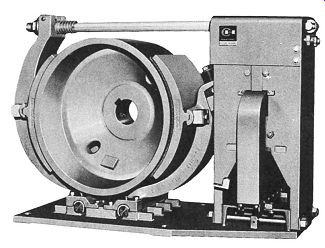
ill. 13 Typical 30-inch brake.
Quick Stop or Slow Stop Many motors are allowed to coast to a stand still. However, manufacturing requirements and safety considerations often make it necessary to bring machines to as rapid a stop as possible.
Automatic controls can retard and brake the speed of a motor and also apply a torque in the opposite direction of rotation to bring about a rapid stop. This is referred to as "plugging." Plugging can be used only if the driven machine and its load won't be damaged by the reversal of the motor torque. The control of deceleration is one of the important functions of a motor controller.
Accurate Stops An elevator must stop at precisely the right location so that it's aligned with the floor level.
Such accurate stops are possible with the use of the automatic devices interlocked with control systems.
Frequency of Reversals Required Frequent reversals of the direction of rotation of the motor impose large demands on the controller and the electrical distribution sys tem. Special motors and special starting and running protective devices may be required to meet the conditions of frequent reversals. A heavy-duty drum switch-controller is often used for this purpose.
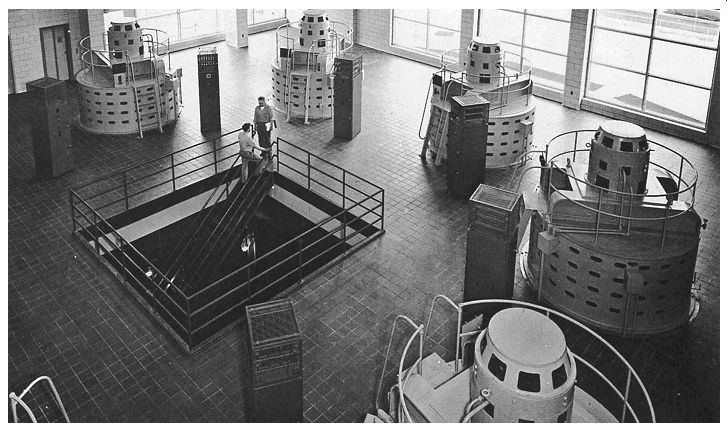
ill. 14 Multiple synchronous motors of 3000 hp and 225 rpm driving water
pumps.
SPEED CONTROL OF MOTORS
The speed control is concerned not only with starting the motor but also with maintaining or controlling the motor speed while it's running.
There are a number of conditions to be considered for speed control.
Constant Speed Constant-speed motors are used on water pumps, ill. 10 and ill. 14. Maintenance of constant speed is essential for motor generator sets under all load conditions.
Constant-speed motors with ratings as low as 80 rpm and horsepower ratings up to 5000 hp are used in direct drive units. The simplest method of changing speeds is by gearing. Using gears, almost any "predetermined" speed may be developed by coupling the input gear to the shaft of a squirrel cage induction motor. A speed reducing gear motor is shown in ill. 15.
Varying Speed A varying speed is usually preferred for cranes and hoists, ill. 16. In this type of application, the motor speed slows as the load increases and speeds up as the load decreases.
Adjustable Speed With adjustable speed controls, an operator can gradually adjust the speed of a motor over a wide range while the motor is running. The speed may be preset, but once it's adjusted it remains essentially constant at any load within the rating of the motor.
Multispeed For multispeed motors, such as the type used on turret lathes in a machine shop, the speed can be set at two or more definite rates. Once the motor is set at a definite speed, the speed will remain practically constant regardless of load changes.
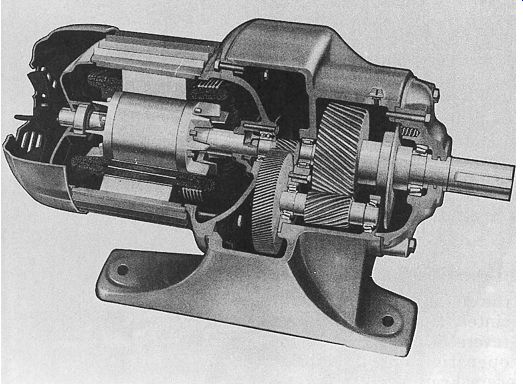
ill. 15 Cutaway view of speed-reducing gear motor (double reduction).
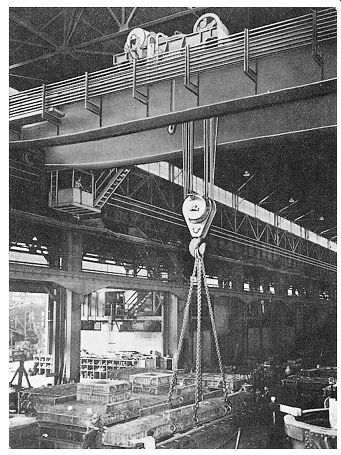
ill. 16 Large traveling overhead crane.
PROTECTIVE FEATURES
The particular application of each motor and control installation must be considered to determine what protective features are required to be installed and maintained.
Overload Protection Running protection and overload protection refer to the same thing. This protection may be an integral part of the motor or be separate.
A controller with electrical overload protection will protect a motor from burning up while allowing the motor to achieve its maximum available power under a range of overload and temperature conditions. An electrical overload on the motor may be caused by mechanical overload on driven machinery, a low line voltage, an open electrical line in a polyphase system resulting in single-phase operation, motor problems such as too badly worn bearings, loose terminal connections, or poor ventilation within the motor.
Open-Field Protection DC shunt and compound-wound motors can be protected against the loss of field excitation by field loss relays. Other protective arrangements are used with starting equipment for DC and AC synchronous motors. Some sizes of DC motors may race dangerously with the loss of field excitation, whereas other motors may not race due to friction and the fact that they are small.
Open-Phase Protection Phase failure in a three-phase circuit may be caused by a blown fuse, an open connection, a broken line, or other reasons. If phase failure occurs when the motor is at a standstill during attempts to start, the stator currents will rise to a very high value and will remain there, but the motor will remain stationary (not turn). Because the windings are not properly ventilated while the motor is stationary, the heating produced by the high currents may damage them.
Dangerous conditions are also possible while the motor is running. When the motor is running and an open-phase condition occurs, the motor may continue to run. The torque will de crease, possibly to the point of motor "stall"; this condition is called breakdown torque.
Reversed-Phase Protection If two phases of the supply of a three-phase induction motor are interchanged (phase reversal), the motor will reverse its direction of rotation. In elevator operation and industrial applications, this reversal can result in serious damage. Phase failure and phase reversal relays are safety devices used to protect motors, machines, and personnel from the hazards of open-phase or reversed-phase conditions.
Overtravel Protection Control devices are used in motor starter circuits to govern the starting, stopping, and reversal of electric motors. These devices can be used to control regular machine operation or they can be used as safety emergency switches to prevent the improper functioning of machinery.
Overspeed Protection Excessive motor speeds can damage a driven machine, materials in the industrial process, or the motor. Overspeed safety protection is pro vided in control equipment for paper and printing plants, steel mills, processing plants, and the textile industry.
Reversed-Current Protection Accidental reversal of currents in direct-current controllers can have serious effects. Direct-current controllers used with three-phase alternating current systems that experience phase failures and phase reversals are also subject to damage.
Reversed-current protection is an important provision for battery charging and electroplating equipment.
Mechanical Protection An enclosure may increase the life span and contribute to the trouble-free operation of a motor and controller. Enclosures with particular ratings such as general purpose, watertight, dustproof, explosion proof, and corrosion resistant are used for specific applications, ill. 17. All enclosures must meet the requirements of national and local electrical codes and building codes.
Short-Circuit Protection For large motors with greater than fractional horsepower ratings, short-circuit and ground fault protection are generally installed in the same enclosure as the motor-disconnecting means. Overcurrent devices (such as fuses and circuit breakers) are used to protect the motor branch circuit conductors, the motor control apparatus, and the motor itself against sustained overcurrent due to short circuits and grounds, and prolonged and excessive starting currents.

ill. 17 Spin-on, explosion-proof enclosure for a combination disconnect
switch and magnetic motor starter. (Schneider Electric)
CLASSIFICATION OF AUTOMATIC MOTOR STARTING CONTROL SYSTEMS
The numerous types of automatic starting and control systems are grouped into the following classifications: current-limiting acceleration and time-delay acceleration.
Current-Limiting Acceleration
This is also called compensating time. It refers to the amount of current or voltage drop required to open and close magnetic switches when used in a motor accelerating controller. The rise and fall of the current or voltage deter mines a timing period.
Time-Delay Acceleration
For this classification, definite time relays are used to obtain a preset timing period. Once the period is preset, it does not vary regardless of current or voltage changes occurring during motor acceleration. The following timers and timing systems are used for motor acceleration; some are also used in interlocking circuits for automatic control systems.
++ Pneumatic timing
++ Motor-driven timers
++ Capacitor timing
++ Electronic timers
QUIZ
1. What is a controller and what is its function? (Use the Glossary and the information from this unit to answer this question.)
2. What is meant by remote control?
3. To what does current limiting, or compensating time, acceleration refer?
4. List at least four devices that are used to control a motor automatically. Briefly describe the purpose of each device.
Select the best answer for each of the following.
5. The general purpose of motor control is:
a. to start the motor
b. to stop the motor
c. to reverse the motor
d. all of the above
6. A motor may be controlled manually by using a:
a. float switch
b. pressure switch
c. toggle switch
d. time clock
7. A motor may be controlled remotely or automatically by using a:
a. drum controller
b. thermostat
c. safety switch
d. faceplate control
8. Conditions that may affect starting and stopping of a motor and the machinery that it drives are:
a. fast or slow starts
b. starting under light or heavy loads
c. how often the motor is started and stopped
d. all of the above
9. Which of the following isn't considered as motor speed control?
a. Constant speed
b. Varying speed
c. Multispeed
d. Short-circuit protection
10. Which of the following isn't a protective feature of a motor controller?
a. Overload
b. Short circuit
c. Adjustable speed
d. Mechanical
11. Which function isn't a fundamental job of a motor controller?
a. Start and stop the motor
b. Protect the motor, machine, and operator
c. Reverse, inch, jog, speed control
d. Motor and controller disconnect switch
12. What factors are to be considered when selecting and installing a controller?
a. Electrical service
b. Motor
c. Electrical codes and standards
d. All of the above